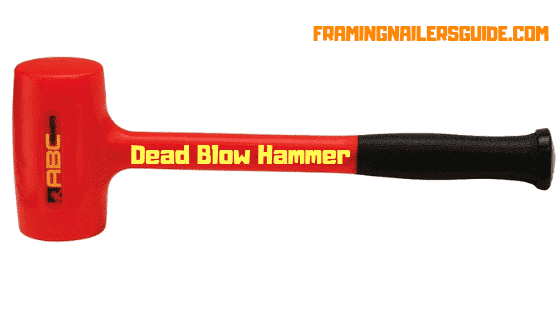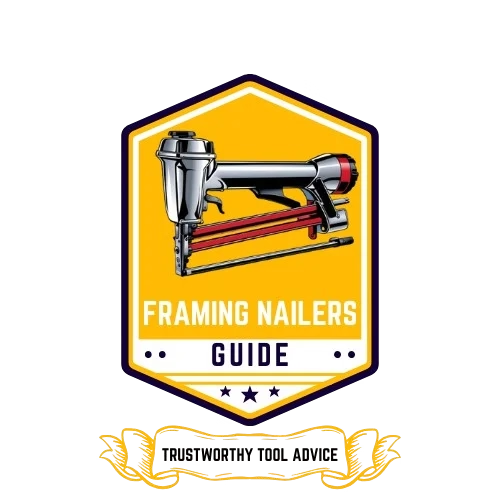Table of Contents
Last Updated on December 16, 2024 by John Patterson
Providing impact forces on surfaces and objects is a day-to-day task for any handymen. If you are a carpenter, woodworker, construction mechanic, or even automotive mechanic, this particular task of applying forces comes your way.
Two of the most convenient tools that people use as an alternative of the regular metal hammer is- the dead blow hammer and the rubber mallets. And in today’s post, we will talk about the head to head differences between these two hand tools.
Seems interesting? Let’s get going-
Dead Blow Hammer vs Rubber Mallet: Comparison

What is a Dead Blow Hammer?

Let’s know the dead blow hammer definition first.
A dead blow hammer is a special kind of mallet. It’s mainly used and designed to deliver decisive blows where no or minimum rebound will occur.
Its structure is the secret of such action as a dead blow hammer. As usual, hammers, this one sports a head and a handle. The head of a hammer is hollow. And it’s filled up with shot or sand inside. And that’s why the force applied by this hammer is spread over a significant amount of time. Also, it reduces the rebound forces while struck.
Uses of a Dead blow hammer\what is a dead blow hammer used for
Using a hammer would be best if you were very specific with the striking action. Making that sure, here go the uses of a hammer-
- First, dead blow mallets are used to assemble parts of wooden and metal products. And the striking force happens to be effective; assembling parts become more comfortable with a dead blow hammer.
- Next, people often work with a dead blow hammer to remove or disassemble joints. For the same reason, disassembling also becomes more comfortable with a dead blow hammer.
- These hammers are called on duty whenever it’s about distributing a striking force for a more extended amount of time. To ensure that it is suited to different kinds of tasks, they often come with modified versions such as heads filled with steel shots, lead shots, or sand.
-
- The Head is filled with rebounding sand, lead, or steel shots.
- It provides a tremendous striking force.
- It doesn’t give much rebound force.
- They are used in assembling or disassembling parts.
- It comes with a safe, plastic, or metal body.
- Safe and easy to work with.
- To control the massive striking force, one should be able to undergo extreme reaction forces while striking.
What is a Rubber Mallet

The structural components of a rubber mallet are just like the regular mallet that handymen use. A large piece of dense and compressed rubber is used as the head, which is attached at the top of the handle. The handle is, therefore, mostly made of wood.
The strength of striking objects is the essential virtue of the rubber head. It’s sturdy and firm enough to give the user extra striking force and strength. The impact force will cause excessive damage to the surface if the surface is not strong enough.
Compared to wooden mallets, rubber mallets are more substantial but can provide more impact forces. On the other hand, they are lighter than metal mallets but come with similar impact forces.
Uses of a Rubber Mallet/what is a rubber mallet used for
What do you use a rubber mallet for? Just like dead blow hammers, rubber mallets also have a wide range of use. Here is a list of a few of them-
- Do dent out metals; rubber mallets are used. Using a rubber mallet for that purpose is quite reasonable as it leaves no marks.
- You can use a rubber mallet to secure parts of it in upholstery. To put or keep parts in their place, you can insert as much striking force as you want with a rubber mallet.
- Highly durable rubber mallets are used to break wooden structures like a cricket or baseball bat. They give quite some advantages to it.
- Instead of metal mallets, rubber mallets provide a significant advantage in terms of weight. So you don’t have to put much effort into working with it.
- Rubber mallets come in place whenever it’s about working with a more straightforward effort on something that demands massive impact forces.
-
- It provides quite an impact force compared to wooden ones.
- It weighs only 12 to 28 ounces, lightens than metal mallets.
- It can be used to put upholstery back in place.
- It can also be used to dent out metals.
- It doesn’t get caught by rust as metal mallets do.
- It doesn’t need many maintenance chores.
- Requires minimum effort to provide high-end impact forces.
- The rebound force is one of the significant factors that the user doesn’t like about rubber mallets.
Rubber mallet alternative-
Real Steel 0421 Non-Sparking Hammer.
Dead Blow Hammer or Rubber Mallet: which one is better?
Now, it’s time to compare the two items- dead blow hammer and rubber mallets head to head. Here are the things to compare in different scenarios-
Rubber mallets weigh less than dead blow hammers. So, rubber mallets are your go-to choice if you are seeking lightweight options to provide striking forces.
Dead blow hammers don’t come up with reactive rebound forces like rubber mallets. So, if you are working on an ultra-hard surface, a dead blow mallet is your choice.
If you seek to cause a break or damage to the object you are working on, a dead blow hammer is the perfect one because rubber mallets don’t come up with that much ability to cause damage to objects.
In Conclusion
At the end of the discussion, we can’t describe any of these two as the clear winner. Instead, we would advise you to pick the right one based on the situation’s demand.
But whichever you choose to work, don’t forget to wear essential safety gear and accessories. As always, keep safety as your first concern.
Related Reading:
#1. Hookaroon and Pickaroon Differences
#2. Cant Hook and Peavey Differences

